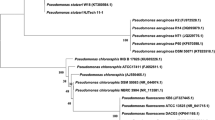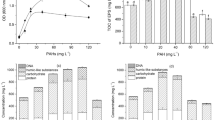Abstract
A Burkholderia and Pseudomonas species designated as AB4 and AS1, respectively, were isolated from soil containing decomposing straw or sugar cane bagasse collected from Brazil. This study sought to evaluate the capacities of culture media, cell-free medium, and crude lysate preparations (containing PHB inclusion bodies) from bacterial cell cultures to stabilize emulsions with several hydrophobic compounds. Four conditions showed good production of bioemulsifiers (E24 ≥ 50 %), headed by substantially cell-free media from bacterial cell cultures in which bacterial isolates from Burkholderia sp. strain AB4 and Pseudomonas sp. strain AS1 were grown. Our results revealed that the both isolates (AB4 and AS1 strains) exhibited high emulsification indices (indicating usefulness in bioremediation) and good stabilities.




Similar content being viewed by others
References
Kitamoto, D., Morita, T., Fukuoka, T., Konishi, M., & Imura, T. (2009). Self-assembling properties of glycolipid biosurfactants and their potential applications. Current Opinion in Colloid & Interface Science, 14, 315–328.
Marchant, R., & Banat, I. M. (2012). Biosurfactants: a sustainable replacement for chemical surfactants? Biotechnology Letters, 34, 1597–1605.
Marti, M. E., Colonna, W. J., Patra, P., Zhang, H., Green, C., Reznik, G., Pynn, M., Jarrell, K., Nyman, J. A., Somasundaran, P., Glatz, C. E., & Lamsal, B. P. (2014). Production and characterization of microbial biosurfactants for potential use in oil spill remediation. Enzyme and Microbial Technology, 55, 31–39.
Xia, W. J., Li, Y., Wang, P., Xiu, J. L., & Dong, H. P. (2012). Characterization of a ther- mophilic and halotolerant Geobacillus pallidus H9 and its application in microbial enhanced oil recovery (MEOR). Annals of Microbiology, 62, 1779–1789.
Abouseoud, M., Maachi, R., Amrane, A., Boudergua, S., & Nabi, A. (2008). Evaluation of different carbon and nitrogen sources in production of biosurfactant by Pseudomonas fluorescens. Desalination, 223, 143–151.
Castellane, T. C. L., Persona, M. R., Campanharo, J. C., & Lemos, E. G. M. (2015). Production of exopolysaccharide from rhizobia with potential biotechnological and bioremediation applications. International Journal of Biological Macromolecules, 74, 515–522.
Satpute, S. K., Banat, I. M., Dhakephalkar, P. K., Banpurkar, A. G., & Chopade, B. A. (2010). Biosurfactants, bioemulsifiers and exopolysaccharides from marine microorganisms. Biotechnology Advances, 28, 436–450.
Bertrand, J. L., Ramsay, B. A., Ramsay, J. A., & Chavarie, C. (1990). Biosynthesis of poly-β-hydroxyalkanoates from pentoses by Pseudomonas pseudoflava. Applied and Environmental Microbiology, 56, 3133–3138.
Rosenberg, E., & Ron, E. Z. (1999). High- and low-molecular- mass microbial surfactants. Applied Microbiology and Biotechnology, 52, 154–162.
Whang, L. M., Liu, P. W. G., Ma, C. C., & Cheng, S. S. (2008). Application of biosurfactants, rhamnolipid, and surfactin, for enhanced biodegration of diesel-contaminated water and soil. Journal of Hazardous Materials, 151, 155–163.
Willumsen, P. A. E., & Karlson, U. (1997). Screening of bacteria, isolated from PAH-contaminated soils, for production of biosurfactant and bioemulsifiers. Biodegration, 7, 415–423.
Peypoux, F., Bonmatin, J. M., & Wallach, J. (1999). Recent trends in the biochemistry of surfactin. Applied Microbiology and Biotechnology, 51, 553–563.
Chen, G. Q. (2009). A microbial polyhydroxyalkanoates (PHA) based bio and materials industry. Chemical Society Reviews, 38, 2434–2446.
Ma, H. G., Liu, M. M., Li, S. Y., Wu, Q., Chen, J. C., & Chen, G. Q. (2013). Application of polyhidroxy alkanoate (PHA) synthesis regulatory protein PhaR as a bio-surfactant and bacterial agent. (2013). Journal of Biotechnology, 166, 34–41.
Boulton, C., Ratledge, C. (1987). In Biosurfactants and Biotechnology, ed. Kosaric, N., Cairns, W.L., Gray, N.C.C., Dekker, M. New York, 47–87.
Robert, M., Mercade, M. E., Bosch, M. P., Parra, J. L., Espuny, M. J., Manresa, M. A., & Guinea, J. (1989). Effect of the carbon source on biosurfactant production by Pseudomonas aeruginosa 44T. Biotechnology Letters, 11, 871–874.
Yang, J. E., Choi, Y. J., Lee, S. J., Kang, K. H., Lee, H., Oh, Y. H., Lee, S. H., Park, S. J., & Lee, S. Y. (2014). Metabolic engineering of Escherichia coli for biosynthesis of poly (3-hidroxybutyrate-co-3-hidroxyvalerate) from glucose. Applied Microbiology and Biotechnology, 98, 95–104.
Soberón-Chavez, G., Le’pine, F., & De’ziel, E. (2005). Production of rhamnolipids by Pseudomonas aeruginosa. Applied Microbiology and Biotechnology, 68, 718–725.
Di Martino, C., Catone, M. V., López, N. I., & Iustman, L. J. R. (2014). polyhydroxyalkanoate synthesis affects biosurfactant production and cell attachment to hydrocarbons in Pseudomonas sp. KA-08. Current Microbiology, 68, 735–742.
Steinbüchel, A., Aerts, K., Liebergesell, M., Wieczorek, R., Babel, W., Föllner, C., Madkour, M. H., Mayer, F., Pieper-Fürst, U., Pries, A., & Valentin, H. E. (1995). Considerations on the structure and biochemistry of bacterial polyhydroxy alkanoic acid inclusions. Canadian Journal of Microbiology, 41, 94–105.
Lopes, E. M., Castellane, T. C. L., Moretto, C., Lemos, E. G. M., & Souza, J. A. M. (2014). Emulsification properties of bioemulsifiers produced by wild-type and mutant Bradyrhizobium elkani strains. Journal of Bioremediation & Biodegradation, 5, 1–6.
Burdon, K. L. (1946). Fatty materials in bacteria and fungi revealed by staining dried, fixed slide preparation. Journal of Bacteriology, 52, 665–678.
Janczarek, M., & Skorupska, A. (2009). Rhizobium leguminosarum bv. Trifoliiros R gene expression is regulated by catabolic repression. FEMS Microbiology Letters, 291, 112–119.
Velasco, S., Arskold, E., Paese, M., Grage, H., Irastorza, A., Radstrom, P., & Van Niel, E. W. J. (2006). Environmental factors influencing growth of and exopolysaccharide formation by Pedicoccus parvulus 2.6. International Journal of Food Microbiology, 111, 252.
Killic, N. K., & Donmez, G. (2008). Environmental conditions affecting exopolysaccharide production by Pseudomonas aeruginosa, Micrococcus sp., and Ochrobactrum sp. Journal of Hazardous Materials, 154, 1019–1024.
Fernandes Júnior, P. I., Oliveira, P. J., Rumjanek, N. G., & Xavier, G. R. (2011). Poly-β-hydroxybutyrate and exopolysaccharide biosynthesis by bacterial isolates from pigeonpea [Cajanuscajan (L.) Millsp] root nodules. Applied Biochemistry and Biotechnology, 163, 473–484.
Anyanwu, & Chukwudi, U. (2010). Surface activity of extracellular products of a Pseudomonas aeruginosa isolated from petroleum contaminated soil. International Journal of Environmental Sciences, 1, 225–235.
Bento, F. M., Camargo, F. A. O., Okeke, B. C., & Frankenberger-Jr, W. T. (2005). Diversity of biosurfactant producing microorganisms isolated from soils contaminated with diesel oil. Microbiological Research, 160, 249–255.
Glazyrina, J., Junne, S., Thiesen, P., Lunkenheimer, K., & Goetz, P. (2008). In situ removal and purification of biosurfactants by automated surface enrichment. Applied Microbiology and Biotechnology, 81, 23–31.
Illori, M. O., Amobi, C. J., & Odocha, A. C. (2005). Factors affecting biosurfactant production by oil degradading Aeromonas spp. Isolated from a tropical environment. Chemosphere, 61, 985–992.
Navon-Venezia, S., Zosim, Z., Gottlieb, A., Legmann, R., Carmeli, S., Ron, E., et al. (1995). Alasan, a new bioemulsifier from Acinetobacter radioresistens. Applied and Environmental Microbiology, 61, 3240–3244.
Ghojavand, H., Vahabzadeh, F., Roayaei, E., & Shahraki, A. K. (2008). Production and properties of a biosurfactant obtained from a member of the Bacillus subtilis group (PTCC 1696). Journal of Colloid and Interface Science, 342, 172–176.
Silva, N. R. A., Luna, M. A. C., Santiago, A. L. C. M. A., Franco, L. O., Silva, G. K. B., Souza, P. M., Okada, K., Albuquerque, C. D. C., Silva, C. A. A., & Campos-Takaki, G. M. (2014). Biosurfactant and bioemulsifier produced by a promising Cunninghamella echinulata isolated from caatinga soil in the northeast of Brazil. International Journal of Molecular Sciences, 15, 15377–15395.
Velázquez-Aradillas, J. C., Toribio-Jiménez, J., del Carmen Ángeles González-Chávez, M., Bautista, F., Cebrián, M. E., Esparza-García, F. J., & Rodríguez-Vázquez, R. (2011). Characterisation of a biosurfactant produced by a Bacillus cereus strain tolerant to cadmium and isolated from green coffee grain. World Journal of Microbiology and Biotechnology, 27, 907–913.
Biria, D., Maghsoudi, E., Roostaazad, R., Dadafarin, H., SahebghadamLotfi, A., & Amoozegar, M. A. (2009). Purification and characterization of a novel biosurfactant produced by Bacillus licheniformis MS3. World Journal of Microbiology and Biotechnology, 26, 871–878.
Asfora Sarubbo, L., Moura De Luna, J., & De Campos-Takaki, G. M. (2006). Production and stability studies of the bioemulsifier obtained from a new strain of Candida glabrata UCP 1002. Electronic Journal of Biotechnology, 9, 401–406.
Acknowledgments
The authors acknowledge the Program of Agricultural Microbiology FCAV/UNESP Campus Jaboticabal and Coordenação de Aperfeiçoamento de Pessoal de Nível Superior (CAPES) for providing a PROAP doctoral scholarship, Post-doctoral National Program (PNPD/CAPES), and Conselho Nacional de Desenvolvimento Científico e Tecnológico (CNPq) for the financial support.
Author information
Authors and Affiliations
Corresponding authors
Rights and permissions
About this article
Cite this article
Sacco, L.P., Castellane, T.C.L., Lopes, E.M. et al. Properties of Polyhydroxyalkanoate Granules and Bioemulsifiers from Pseudomonas sp. and Burkholderia sp. Isolates Growing on Glucose. Appl Biochem Biotechnol 178, 990–1001 (2016). https://doi.org/10.1007/s12010-015-1923-5
Received:
Accepted:
Published:
Issue Date:
DOI: https://doi.org/10.1007/s12010-015-1923-5




